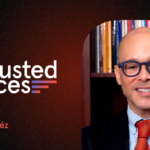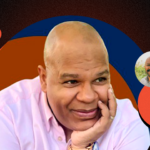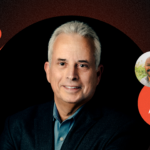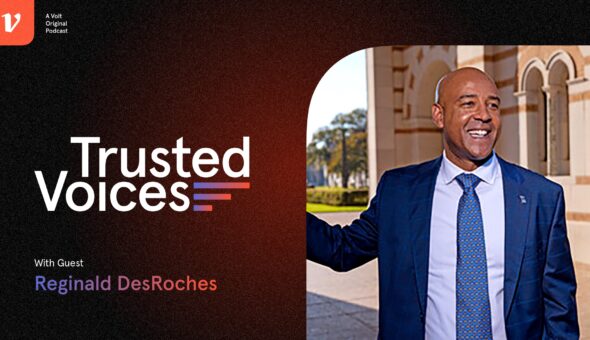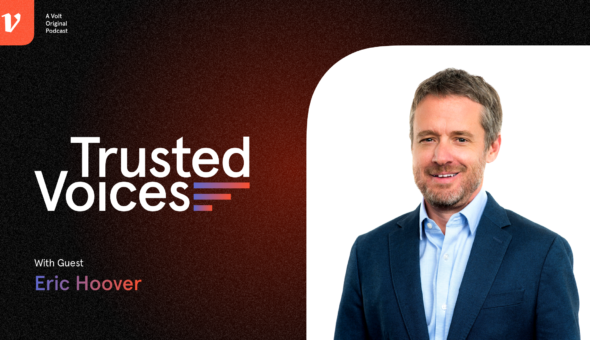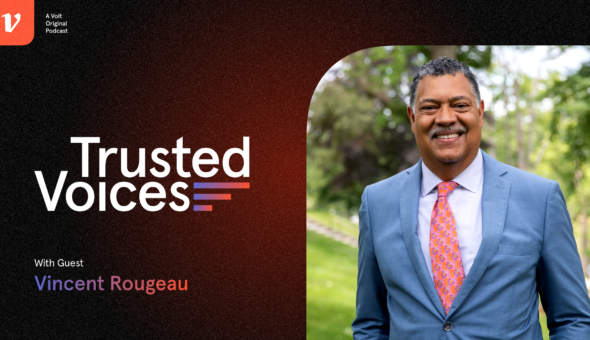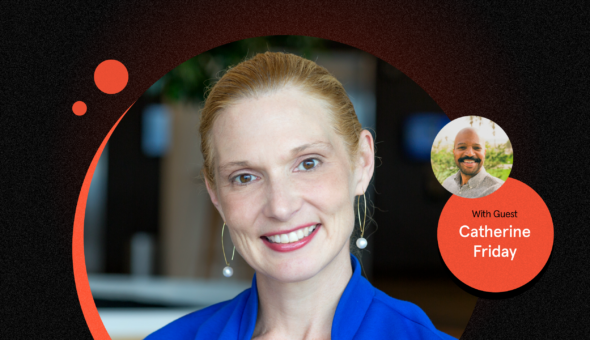On the latest episode of Trusted Voices, Amy Privette Perko of the Knight Commission on Intercollegiate Athletics joins Teresa Valerio Parrot and Erin Hennessy to discuss the NCAA’s new president, former Massachusetts Governor Charlie Baker; the rapidly evolving state of NIL; and how the NCAA transfer window might impact the transfer of college credits for student athletes. Plus, on the cusp of March Madness, the group discusses the NCAA’s efforts to increase equity among male and female basketball players two years after a viral reaction to the women’s basketball players showing the difference in equipment, accommodations, food and playoff experience versus their male peers.
And to kick things off, Teresa and Erin take a quick look at other headlines from the world of higher education communications, including the widely panned decision by Vanderbilt University’s Peabody College of Education and Human Development to respond to the mass shooting at Michigan State University with an email written by ChatGPT; as well as the decision by Ruth Simmons, now-former president at Prairie View A&M University, to leave her post four months earlier than originally planned and join Rice University.
Show notes:
- Vanderbilt University apologizes after using ChatGPT to console students (ABC News)
- NCAA announces Massachusetts Gov. Charlie Baker as next president (ESPN)
- KNIGHT-NEWHOUSE College Athletics Database (Knight Commission)
- 2023 NCAA CONVENTION SESSION: MATERIALS AND RECORDING (Knight Commission)
- CLA PROJECTIONS ON FUTURE FBS AND POWER 5 SPENDING (Knight Commission)
- The Coach Credentialing Program (United Soccer Coaches)
- Ruth Simmons will resign early as president of Prairie View A&M University (The Texas Tribune)
- Ruth Simmons to join Rice as President’s Distinguished Fellow (Rice University)
Read the full transcript:
Teresa Valerio Parrot:
Hello and welcome to the Trusted Voices Podcast. I’m Teresa Valerio Parrot, alongside Erin Hennessy, and in each episode, we discuss the latest news and biggest issues facing higher ed through a communications lens. For these conversations, we’ll be joined by a guest who will share their own experiences and perspectives. This week, in advance of March Madness and while conversations are raging over the many changes underway in college athletics, we are honored to talk with Amy Perko, President of the Knight Commission. But before we chat with Amy, I’m curious, Erin, what’s on your mind?
Erin Hennessy:
I, not surprisingly, have been following a lot of coverage that has come out of the aftermath of the recent shooting at Michigan State and it’s interesting to see how many ways these tragic events touch institutions across the country. It also provided an intersection this weekend with an issue that everybody in higher ed seems to be talking about, which is ChatGPT. The Peabody College of Education at Vanderbilt University sent an email to their students reflecting on the Michigan State shooting that was generated by ChatGPT, that was AI-generated, and this spawned a lot of conversation, a subsequent apology from the institution.
I think it just brings together so many issues that you and I talk about, crisis preparedness, trying to find language to address larger events in society that impact our students and our institutions, so I was just really fascinated by the coverage and fascinated by the thought process that went into this decision to use ChatGPT to come up with a message to students. Before I let you chime in on this one, I do want to note, one of the hardest things institutional communicators have to do is respond to these tragic events. Whether it is systemic racism and its impacts and outcomes or it’s a mass shooting, it is incredibly difficult to find words to communicate about these incidents that feel both not hackneyed and feel relevant to our institutions and our students. I don’t mean to dismiss that challenge, but as I think we saw over the weekend, ChatGPT and AI is not the way to navigate that challenge. Did you see anything interesting on that story that you wanted to dive in on?
Teresa Valerio Parrot:
Beyond seeing something interesting, I’ve had so many conversations with people over the last three days about it. But I do want to start, I want to take a step back and just express my condolences to the Michigan State community and family and to really, the larger community that has been impacted by this, because it’s not as if tragedies like this are place-bound, they really impact so many people. As we’ve seen, the state of Michigan is really coming together in some really powerful ways and the impact of that tragedy just resonates across the country. With someone who has a college-aged daughter, those sorts of moments always give me pause, so condolences to the Spartan family.
As I think about this, I think there is a difficulty. I was having a conversation yesterday with my colleague, Jenny Petty, at the University of Montana, and she had a great point, which is there are only so many words that we have in the English language and there are only so many ways to put them together, and sometimes it feels overwhelming to find the right words for the right moment. And then in our discussion, we pivoted and I said, “I can appreciate all of that, and I also think that if you use something like ChatGPT to develop language, at the very least, take off the little line at the bottom that says, ‘This was generated by ChatGPT.'” I think it raises some more fundamental questions for me about when is it appropriate to use resources like this? If people do feel that they don’t have the ability or the emotional bandwidth to write something like that, because you have to be able to separate your emotions from the situation, then we might need some additional resources, tools, and training for our team members.
I would also say this is an interesting question about who sends out these messages, because this was sent out by a program, this wasn’t sent out by the institution, the institution had already sent their statement. That’s an important discussion to be had on our campuses about who develops the language, do they have the skills and resources to do it, and who sends? Because some of these, at some point, you and I have talked about this, feel performative because everybody feels like they have to send it. If that’s the case, I would say all around, this is a reflective moment for our industry and I regret that an institution has to go through this reflection so publicly.
Erin Hennessy:
You’ve raised so many good questions there. I wish there was a moment for a larger conversation about how we as institutions respond to these kinds of things, because you and I spend a lot of time working with presidents and senior leaders around trying to put some kind of guardrails in place or ways to think about when we respond publicly with a statement and when we don’t. At the same time, we’ve spent a lot of time with faculty members lately who are urging us to see ChatGPT as a tool, not a replacement. But I could see using something like a language generator to give you that first draft, particularly when you feel that you are just out of ways to grapple with this in writing. I think there are several big misses there, the tagline is one of them, but that the email wasn’t edited to include resources that were specific to that school within the university to really resonate and be relevant to this program, this institution. You and I talk all the time about making sure that that is the case in language that we share with our communities in times of tragedy.
Teresa Valerio Parrot:
Well, I think there’s a real reason for that, though, for that miss, and that is my ultimate litmus test for a statement always is the litmus test of common sense. If you’re using a program like ChatGPT, that means that we have to have the humans who receive the language double down on the common sense application of what it is that they just generated, and that, I think, is a lesson for all of us, as well. One more thing that I have been watching and I am just intrigued by is recently, Prairie View University let go of their president, Ruth Simmons, who had already announced that she was going to be stepping down, but they expedited her exit.
This is one of those moments where I don’t know what’s going on, I don’t know what all of the details are, I am seeing bits and pieces, but I think one of the hallmarks that we encourage for boards is to remember that how you treat your outgoing president is significantly important to inform your relationship with your incoming president, and it also tells in the future, when you have an additional transition at some point, how you might be treating the next cadre of leaders, as well. I have to say my heart was happy and I was so pleased with Rice University for picking up Dr. Simmons and having her have the kind of esteemed position that she has earned over her career as her exit before she retires. What an amazing resource Rice University was able to snatch up and have available to their campus community and to their students and to their faculty. I was pleased that there was grace for Dr. Simmons and I was also ecstatic that there was significant opportunity and resources to that campus community, as well.
Erin Hennessy:
We’re going to spend a lot of time talking about athletics in this episode and you know I’m almost instantly out of my depth in those conversations, but I feel confident in saying that in the higher ed draft, Ruth Simmons would be everybody’s number one draft pick. I would let Ruth Simmons do whatever she wanted to do as an institutional leader. She is a remarkable individual with a remarkable personal story, and as you said, went from Ivy League institution, went to Prairie View because she believed in the mission and the work of the institution. I am also thrilled to see that she is going to finish her career at an institution that’s really welcoming her with open arms. I know it’s an institution that is near and dear to your heart, which only adds to, I’m sure, your pride in that decision, so congratulations, Dr. Simmons, and congratulations, Rice.
Teresa Valerio Parrot:
Yes. I have to say that I think the President of Rice, Reggie DesRoches, kudos to him for seeing an opportunity both to honor a colleague and also to really give another pillar to how he’s building his presidency. I could just not be more thrilled for how he is thinking about the opportunities that he provides. I know sometimes we talk about here’s what we’re seeing and it might be negative, but that was a negative that turned into a positive for an institution, I just worry for the institution that will have the ongoing negative associated with it.
Erin Hennessy:
Yeah, agreed. Well, I don’t want to delay our conversation with our guest any further, so I will toss it to you to introduce Amy Perko.
Teresa Valerio Parrot:
Amy Perko has led the Knight Commission since 2005, serving as executive director until October 2016, when she was named chief executive officer. During Amy’s tenure, the NCAA has adopted a number of the Knight Commission recommendations. The most prominent of these actions include requiring teams to be on track to graduate 50% of their players to be eligible for post-season championships, reducing athletic time demands on college athletes, and revising its revenue distribution to include incentives for academic outcomes. The Knight Commission recommended all of these actions in its 2010 report, Restoring the Balance: Dollars, Values, and the Future of College Sports. A member of the Wake Forest Sports Hall of Fame, Amy was named to CoSIDA’s Academic All-America basketball team three times and earned All-ACC honors twice. She was honored as an ACC legend in 2005 and in 2008, Amy was inducted into CoSIDA’s Academic All-America Hall of Fame. She graduated summa cum laude and Phi Beta Kappa in 1987 with a degree in history and she earned a master’s degree from the University of Richmond. In December of 2015, Amy was awarded an honorary degree from Methodist University.
Erin Hennessy:
Amy, it’s a great time for us to be having this conversation with you because there’s so much going on about college athletics, although I think we’d be hard-pressed to point to a time when there isn’t so much going on with college athletics. But I think where we wanted to start was getting your thoughts on the upcoming leadership transition at the NCAA. As I’m sure many of our listeners know, Massachusetts Governor Charlie Baker will become president of the NCAA following the end of Mark Emmert’s 13-year tenure in that role. I’m wondering, first of all, how you would look back and assess the Emmert era of the NCAA?
Amy Perko:
Great question. The past decade has been the era of the student-athlete, but in many ways that era was forced on the NCAA. When I talk about the NCAA, let me be clear that this is not just about Mark Emmert, but about the primary Division I policymaking board, which is controlled by university presidents and primarily the Power Five presidents, presidents of those Power Five conferences. But over the past decade, it’s also been a very litigious decade and Emmert and those presidents made choices that, in my view, positioned the NCAA as reactionary and not leading. The NCAA over the past, again, decade, really was clinging to the status quo and was forced to make changes instead of really creating a vision for a new era.
But again, this past decade, if you look at the changes that have occurred, it has been, again, the era of student-athletes, more student-athlete-friendly rules around transfer rules, providing more freedom for student-athletes, NIL, allowing athletes for the first time to ever receive endorsement compensation, and expansion of educational benefits, but every single one of those things were forced through litigation or through changes in state laws. I think in the big picture, and this is also a flag for what to look for in the future, there have been a lot of missed opportunities, missed opportunities to really…
One of the positives, as well, of the past era has been a result of academic policies that changed, even before Emmert’s tenure, that we’ve seen results be the highest graduation rates ever among college athletes in Division I, so I’d say it’s a real missed opportunity, too, to really double down on the education and the educational opportunities. It is also a missed opportunity with gender equity and there are a lot of things that still need to be done in that area of gender equity. One other really issue and opportunity over the past decade, and this, you’ll hear from college sports leaders saying they haven’t done enough to tell their story about all the positive results of college sports, and I agree with that. College sports are vehicle to build leadership in young men and women and help them reach their human potential, that’s why we have it, and so there are a lot of threats moving forward about how that relationship could change in total, so a lot of work still ahead for, now, the new president, Charlie Baker.
Erin Hennessy:
What do you expect from the next 10 years or from the Baker era, however you want to look at that, and what does it say that the NCAA went out and hired themselves an elected official? Is it finally going to be this era of congressional engagement and oversight that everyone’s been predicting for the last several years, or do you see something else at work in that selection?
Amy Perko:
I think two things. One, I think it’s a real positive to have a fresh perspective, and I would say we hope that one of the things that he will study and take to heart and bring about, we’ve been pushing for a long time for independent directors to be added to the Division I policymaking board. As leaders know, at universities, there are independent directors of universities, and so it’s been surprising to us that that recommendation has been rejected by the Division I policymaking board, that they did adopt that at the Board of Governors level, so there are a couple of independent directors on the Board of Governors level, but that board doesn’t have near the authority for the policy that really drives Division I sports and really drives the entire landscape.
Fresh perspective is good, I think clearly, though, the presidents wanted to have a leader who could work with Congress to try to get some legislation to help stabilize college sports. Now, we have several issues that we think Charlie Baker should prioritize and really that the NCAA, under Baker’s leadership should frankly, in our view, abandon its current congressional Hail Mary strategy and really pursue a reform now strategy, which will help them get congressional legislation. I talked about one of those things would be independent directors, another one would be eliminating some very significant and troubling gender inequities that continue to persist, and number three would be management and enforcement of NIL rules, regardless of whether Congress gets involved.
And then number four, and probably one of the top, is correcting the misalignment in which the NCAA acts as a legal shield for the sport of FBS football, but yet FBS football really is controlled a lot through the college football playoff, what that means to the scheduling and everything that happens, and then the college football playoff is separate from the NCAA, it’s an independent LLC. The NCAA makes zero, zero in revenue from the college football playoff, from FBS football, and that is the most misunderstood fact among college presidents, boards, fans, media. The NCAA has basically punted on that issue because it’s challenging, but it’s at the heart of a lot of the litigation, it’s at the heart of a lot of issues, and so they’ve got to figure it out.
Teresa Valerio Parrot:
I think as you talk about that, that is such a little known fact. Whenever I mention that to people, they look at me a little bit gobsmacked, they’re surprised that that’s the reality. There’s another element that usually makes eyes widen quite a bit, and that’s when I say the NCAA is a member organization, those who lead the NCAA are member university and college presidents. Those two facts, usually people just stop and look at me, and I’m sure they think I’m inventing some facts. With that, I think it leads to the reality that there are these misconceptions about what goes on with college sports, and part of that is because, I think it’s because we have this disjuncture between how the NCAA and institutions talk about intercollegiate athletics and the way that it’s lived.
In essence, that’s the difference between how the NCAA advocates for purity of amateur sports and a number of the different elements that you were talking about, some of these concepts that are wearing thin with a number of people because they say certain things, but then on the other side of that, there’s the reality of this billion dollar industry that the NCAA and the conferences and all of the other organizations market and promote. The Knight Commission has issued a number of reports and recommendations on this divide and I’m curious if you think that ideological split is growing in light of NIL and conference realignment and if some of the other big changes underway are really widening that divide, and are there ways to narrow it?
Amy Perko:
Great question. I think I would start by saying the Knight Commission recommendations, we’ve worked really hard to start with the principles. If you go back, too, the NCAA went through a constitutional rewrite process now two years ago, and again, the principles are pretty consistent with what they were previously. But the point has been that the principles have not been consistently put into action and into policy, and that’s why a lot of these arguments are breaking down and that’s why you’ve seen a shift in the public view. If you have a principle of gender equity as one of your constitutional principles, which the NCAA does, then you can no longer have a revenue distribution policy that awards $170 million a year based on the performance of men’s basketball teams only.
That, in and of itself, and what has happened with that issue shows you why the NCAA is struggling, because two years ago, the NCAA hired a law firm to do a gender equity assessment, Kaplan Hecker. That law firm issued a report to the board, a number of recommendations were made, and the NCAA acted on a number of those recommendations, but the NCAA punted on one of the most difficult recommendations, which was change your revenue distribution policy because it’s gender inequitable. When you start dealing with the money, that’s when it gets challenging and they’ve punted and they haven’t addressed that issue. That’s one issue, and we can come back and talk about that, but I think that’s a really good one because you can read the NCAA Constitution, read the principle and then say, “Where’s the disconnect? Why is this still happening when they’re under fire in so many ways?” You would think that that would be a reason for them to act more quickly.
But in terms of, again, your question, I think also speaks to the structure itself, does this structure work now?
Teresa Valerio Parrot:
Yes.
Amy Perko:
There has been such an explosion of revenues. You have Division I programs. In Division I, you have more than 330 schools in Division I, you have athletic programs that have budgets of $5 million, you have athletic programs that have budgets of $250 million, and so that’s the question. March Madness, the tournament, is the glue that holds those diverse institutions in this association really wanting to compete and be in the same division, but again, our point is we really have to get the structure. Does this structure really work? Is this structure outdated?
I talked earlier about the college football playoff and how it’s a separate entity, and that’s where we think the structure has to be corrected. We’ve recommended that there be a different governance structure for FBS football and the CFP revenue should be used to pay for catastrophic insurance for football, the CFP revenue should be used to pay for the legal fees associated with FBS football. All that now falls to the NCAA to pay for with March Madness revenues. Again, the sport of FBS football, the CFP currently generates about $500 billion a year and with the expansion, those revenues are going to soar past what the NCAA generates, so we’re looking, potentially in three years, the CFP could generate over $2 billion a year.
When you’re talking about new revenues, and we’ve had a financial services firm do projections with the new revenues coming in from the CFP, the SEC, and the Big 10 will receive a lot of new revenues, so their media contracts, so you’re potentially looking at, in three years from now, there’s going to be another 1.4 billion in new revenues coming into the system that already is tearing apart at the seams because of the ways in which the past new revenue has gone disproportionately to coaches salaries, severance pay, buyouts of coaches, which has reached ridiculous levels that ADs, presidents boards all agree are ridiculous levels, and yet there’s been no effort to try to address those root issues and there’s been no effort to say, “Let’s get this structure and this system corrected before all these new revenues come in.”
There’s a lot going on and a lot to connect all those dots. But that’s why we don’t think Congress is going to say, “We’re going to give you a free get out of jail antitrust card and we’re going to give you an exemption just on NIL,” because there are so many issues and there have not been solutions brought forward by the NCAA to address some of these broader issues of making sure that all of these new revenues, the money should be used to strengthen the educational mission, to go towards health and safety, to go towards mental health and athlete wellbeing. There’s enough money there to do all those things that need to be done, but they’re not acting as proactively as they need to about those things.
Erin Hennessy:
When you talk about being reactive, and you mentioned NIL earlier, we’re coming up on the two-year anniversary of this new approach to compensating student-athletes, what’s your thought on where we are in terms of NIL? What surprises have you seen in how this has rolled out and how both institutions and students and sponsors are reacting to this new world order?
Amy Perko:
The biggest surprise is probably that the NCAA has failed to enforce its own rules. Again, let’s talk about the principles, there were only two basic principles at the NCAA were going to apply here, because again, they were forced into the change. I do want to say from the outset, the Knight Commission, we held the first-ever national meeting on name, image, likeness issues in 2008, 2008, and that was when video games, the avatars were starting to look a lot like the actual players. Some people criticize us for that, that seems pretty trivial. But fast forward, we issued some guidelines in 2020 that we hoped the NCAA would use to adopt them to help create the new structure.
The NCAA had a task force and their guidelines were pretty similar to ours. I bring that up because if those guidelines have been put in place, we wouldn’t have the chaos we have now, but again, the NCAA decided to wait. They were trying to wait for some litigation to work itself out and by waiting, they put themselves into reactionary mode. Then that reactionary mode has been they are scared to enforce their own principles, which were cannot be used as recruiting inducements and schools can’t be involved in arranging NIL. Both of those issues are being violated and being violated openly.
As it relates to NIL and endorsement pay, frankly, pro sports have more rules than college sports. There’s a lot I could go into about that, but just that basic statement is true and you can show it in facts. But I would say on the positive side, we were supportive of this opportunity so that athletes, just like non-athletes, can receive endorsement pay. Certainly, social media and being a social media influencer, I think that was a turning point in how people begin to realize athletes are restricted in ways non-athletes are not, so it has been very good for just athletes, generally. I do think there will need to be some ways in which they look at changing the structure, because it really is being used as pay-for-play currently, in a lot of ways.
Erin Hennessy:
What do you think it’ll take for the NCAA to actually enforce those rules, those principles, that they laid out?
Amy Perko:
Well, they’ve recently issued some clarifying guidelines, so I think everyone’s still waiting to see if they actually will enforce the rules. But clearly, this was a priority of the president’s when Charlie Baker was selected to try to get some kind of uniform congressional legislation that would address NIL, because there currently are different state laws around NIL. Now, that said, again, from everything that we’ve seen and heard, we do not think they’re going to get bipartisan support for a narrow NIL bill because the questions are why should Congress get involved in some legislation that would appear to be restrictive of athletes, when the college sports system will have a billion more dollars in new revenues and it’s not clear to them how those revenues are going to be restricted or directed in ways that better support athletes? That question runs to the entire system and that’s why I think it’s going to be really difficult just to get a narrow NIL bill.
Teresa Valerio Parrot:
Well, I do have to say, as an alumni of the University of Colorado and having attended at a time when Jeremy Bloom was there, that I have always been pleased that the Knight Commission has given him the opportunity to tell his story. You all have been talking about this for many, many years, including, I remember when you all had that meeting and there was a bunch of grumping about were you really getting, oh, thank you to Jeremy, here we go, out over your skis as you’re talking about those topics? Thank you for continuing to bring that to the forefront and for being a leader in what you saw was coming ahead. I do want to shift to something that you had talked about a little bit earlier.
I recently was talking to a president about the changes underway in intercollegiate athletics and she noted that people expect NIL to be her biggest concern with current policy and practice shifts, and instead, she’s worried about something a little bit different that you raised, and that’s the transfer portal process and what it means for students’ graduation rates. What she said is she’s having her athletic department track this very carefully, because she has concerns that students who transfer to multiple institutions are going to burn through their eligibility and at the end of their time at all of the institutions that they attend, they won’t have the credits needed for a degree. How is the Knight Commission and how are you thinking about this unintended outcome of student-athlete choice, and are there ways for us to be thinking about solving that across the industry writ large?
Amy Perko:
I think it’s a great question. I think it is really important to look at the data on this and it will be important to spend some time on that data, because when the effort was made to improve graduation rates, the NCAA developed the Academic Progress Rate, it’s a management tool to help track eligibility and retention. We all know that retention is one of the greatest factors for successful completion, and so when you have athletes bouncing around from year-to-year, that’s going to hurt the graduation rate. I do think one potential solution to go back to is, just across the board looking at the way the rule used to work, and then they have opened it up, but it was that athletes, you could transfer one time and be immediately eligible. Now, there’s been more of an opening of waivers and other things when that happens a second time if they’re not a graduate, so you had graduate transfers that you don’t have those same concerns about.
I think there’s a way to look at you’ve got to apply it across the board. The problem in the past was you had the one-time transfer rule that applied to all sports except football, basketball, and I think ice hockey. You’ve got to treat all sports the same with regard to that, but I do think you can apply it and do away with all the waivers across the board. What makes it challenging is when the NCAA has responded to certain waivers, and so then it just, you can’t say no in some cases and yes in other cases, and so that may be something that they have to look at.
Because again, looking at it from the student-athlete wellbeing standpoint, anytime you go to a new situation, it’s challenging. If the ultimate goal is the student-athlete wellbeing and progress toward degree, then there should be some incentives or disincentives, if you will, to allow an athlete time for that adjustment at a new institution. I think one of the other aspects of this that we’ve been pushing for, again, for years, and kudos to United Soccer for implementing this, but coaches have a role, an important role, as well, and recognizing the coach’s role as an educator and the coach-athlete relationship can also be one of the biggest factors of whether the athlete has a positive experience or negative experience or feels like this place is not for me anymore.
College coaches don’t have to have any kind of credential, any kind of license to show they are prepared to be a college coach. Our point has been we are educational institutions and we believe college coaches should at least have some minimum standards, some kind of credential to show that they’re prepared for their roles, which are very difficult and challenging roles, in this not only the X’s and O’s of the game, but that coach-athlete relationship, and their goal should be, “Every athlete I recruit, I want that athlete to achieve a degree here,” and so that coach-athlete relationship is critical.
Again, I mentioned United Soccer, the Knight Commission, we gave them a grant to help support their effort to award… They have 60 hours of curriculum for the first-ever college coach credential. They had just outstanding reaction from their coaches when they first opened it up and they wanted a small class of 40, but then they expanded it to 60, because they were surprised they got so many head coaches that wanted this opportunity and they knew they needed to create some opportunities for assistant coaches. They’ve got head coaches with more than 10 years of experience, some national championship coaches, so that just shows you there’s an appetite from coaches to know our roles have changed quite a bit.
Coaches want to learn, as well, how can I do this job to the best that I can so that I am supporting the athletes? We were really pleased with what United Soccer’s done and we hope that can be replicated in other sports. I just really want to hold up that opportunity, as well as another point, another opportunity that presidents and boards should really see that as an opportunity for my institution, I want all of our coaches to have their credential to show that we are committed to helping coaches be the best they can be in this coach-athlete relationship.
Erin Hennessy:
I think that’s such a fantastic opportunity for institutions, and I’ll speak for Teresa, noting that when we interact with an institution that is navigating a reputational issue within their athletics program, it is oftentimes not just the behavior of one or two coaches or athletes, it’s a cultural issue that can pervade the organization. Having that kind of curriculum and that kind of development opportunity for folks who are coming into this position and really working to develop scholar athletes, if we’re sticking with the mission of collegiate athletics, I just think that’s a phenomenal opportunity for institutions and I hope that does spread in the way that you all are hoping to see.
We see that athletics serve so many functions within higher education and you pointed out several of them, Amy, including leadership development for student-athletes, ways to strengthen the connection that institutions have with alumni and fans, way to drive economic development in the home community, but we also are seeing athletics being used in less public ways. We’ve certainly seen a lot of institutions that are facing financial uncertainty and believe that using athletics is a way to attract additional full-pay students or to court significant donations from those alumni and fans that we mentioned. Is that a smart play considering the investment that’s needed to stand up additional teams, to construct new facilities, when we know that most institutions and most athletic programs are not earning back in revenue the dollars that the institution is putting in to fund those programs?
Amy Perko:
It’s a great question. I would say it goes to institutional philosophy and mission. Again, athletics, in our view, in the Knight Commission’s view should be viewed as part of the educational mission because of the great opportunities it does provide that learning lab, if you will, for young women and men to learn the lessons of setting goals and working towards your goals, teamwork, resiliency, communication, relationships, just all those things. It’s a reason why athletes are sought after from employers, because they’ve experienced all those things that you encounter in that work environment. But again, in terms of the investment, I do think schools are going to have to really look hard at this in terms of are we in the right division? Because again, the structure could really change and are we in the right division, is our investment consistent with what our capability is and what our mission is?
We have a database, you can go to it on knightnewhousedata.org, and it’s a partnership with the Newhouse School at Syracuse University, and it tracks Division I public institutions and provides very simple visuals in data on where the money comes from in athletics and where the money goes. One of the trends you’ve seen over time, though, for the schools outside of the Power Five conferences, and the Power Five conferences certainly have significant media contracts and revenues, but outside of that, most of the programs are supporting their athletic opportunities with student fees and institutional support, so understanding those levels. It is concerning when you start seeing those trends of student fees and institutional support growing much more rapidly for athletics, growing much more rapidly than the academic enterprise at the institution. Those are the types of trends that boards and presidents do need to track.
Now, one of the important pieces of data that we don’t have in our database, and it’s because interestingly, the NCAA doesn’t track it, all our data comes from what the institutions report to the NCAA, but the NCAA does not track those tuition dollars that you mentioned, the tuition dollars that athletes are paying in some of those sports that either the institution may not provide scholarships or may not provide it in particular sports. We do know, as an example, in Division II schools, Division III schools, athletics is a very different, obviously, kind of philosophy, and also the financial underpinnings are very different for Division II and III, but they are providing those athletic opportunities to help with driving enrollment.
Athletics done right anywhere provides just tremendous opportunities for the athletes, so again, I think it’s important for institutions to look at what those financials are, but also, and I would say this particularly for Division II and III, maybe some of the smaller Division I schools as they look to add sports, one of the mistakes that presidents and boards have made and administrators is looking at just, here’s what it’s going to cost us to add this sport from a competition standpoint, getting a coach, and they’re underestimating what they need to put into the student-athlete health and wellbeing piece of it. Athletic trainers, that entire field, it’s huge demand from schools and they can’t find enough professionals in that area, so that’s an area that has to be front and center as schools are looking at what their investment is and it’s an area that needs to grow instead of being cut. There may be some ways schools can work together to consolidate and provide that help and support, and schools are looking at ways to do that, particularly in the mental health space, as well.
Teresa Valerio Parrot:
Amy, you mentioned the Knight-Newhouse College Athletics Database. We’ll add that to the show notes, because it is a really fantastic site. As a nerd who has spent a lot of time on that site, I have to say it’s really impressive, especially because it gives you a better sense of where the money comes from, as well as where it goes. I think that’s a really important way for us to think about what’s valued and prioritized with how institutions are receiving and spending money.
With that, we have one final question for you, and part of the reason why we have you on the podcast at this time, and that’s because we are just weeks away from March Madness. You mentioned this earlier and you’ve had Title IX as a component of a number of your answers, and I want to go back to that specific to March Madness. With that just around the corner, it’s now two years since we had the women’s basketball players who noted the significant differences in equipment and accommodations and food and overall playoff experience versus their male peers. How well do you think the NCAA has responded to the equity critiques raised? You talked about that a little bit and said you’d be happy to share more and we’d love to hear more.
Amy Perko:
Sure.
Teresa Valerio Parrot:
What advice do you have for the NCAA and its member campuses as we head into another March Madness season?
Amy Perko:
Great question. I think in terms of the response to, again, the Kaplan Hecker report that law firm provided to the NCAA Board outlined a number of changes that should be made, particularly with regard to men’s and women’s basketball and comparing those tournament experiences. The NCAA responded and prioritized and made significant changes to put those on par with each other, but again, as I mentioned, one of the most important and critical ones is revenue distribution. We know that incentives and rewards speak to values, what an institution values, what an organization values. Again, the NCAA has a principle of gender equity in saying that it will operate in a gender equitable way, we still haven’t heard of an explanation at all as to why they haven’t addressed the inequity in its revenue distribution.
Our standpoint, as a nonprofit higher ed association, it doesn’t matter where the money comes from in your big pot of money, and so if you as an organization, which the NCAA has said, “We’re going to reward performance in men’s basketball at the level of $170 million a year,” so how teams do this coming March in the tournament will result in their conferences and the institutions receiving more money, and the NCAA continues to choose not to reward women’s basketball in the same way. Our solutions are either, number one, you do away with athletic performance incentives altogether as an association or you make it so it’s gender equitable. If you’re going to reward athletic performance of men’s teams, then you have to reward athletics performance of women’s teams. If they choose to reward basketball and baseball and ice hockey, then reward women’s teams on the same side. It’s pretty simple, but it’s been over 500 days since Kaplan Hecker said that to the board.
We had a similar recommendation over a year and a half ago around our solution, which is a care model that is a little bit more complicated and would take another podcast to go through. Not complicated, because it basically says, “Here are your principles, put those principles into action in how you reward the money and how you use the money,” so actually, that’s pretty simple. But the NCAA, it continues to be bogged down in committee and it’s bogged down in committee because anytime you change the money, it gets difficult. But again, we’re getting ready to see, when I said 1.5 billion in new revenues coming in, there’s no better time to change the financial structure and major policies about how money is rewarded or where the money goes when there’s new money coming into the system.
Erin Hennessy:
Agreed.
Amy Perko:
Again, that’s where we think Charlie Baker has a great opportunity, but it has got to be more than, “Congress help us out because college sports is a great opportunity for young men and young women.” We support that, but you’ve got to have some bold solutions on the table that say, “All this new money, it cannot go to where it’s gone before.” We have data that is on our website that you can look at and look at those trends and you can understand, yes, that is not viable. If it continues to flow to coaches’ salaries, football coaches’ salaries, football coaching buyouts, the structure will collapse.
We don’t want it to collapse, so that’s the reason for both solutions. March Madness is a great opportunity, again, for leaders to say, “The number one thing we’re going to do before we ask Congress for help is we’re going to show you we’re going to realign our incentives with our gender equity principle and we’re making the change today.” That’s a change the NCAA Board could make today, so again, for everything that’s at stake, it doesn’t make sense to us why, in this case, they continue to punt that issue, or to pass it off, to use a better basketball analogy.
Erin Hennessy:
Perfect. Thank you, Amy, so much for spending time with us today and providing us really so much to think about as Teresa and I plan to come back together in a couple of days. For our listeners, we’ll be back in your feed shortly to share what resonated with us and what we hoped you’ll take from this episode, but between now and then, you can find links in the show notes to some of the topics and articles we referenced, including databases and coaching credential programs. Make sure to follow Trusted Voices wherever you get your podcasts and until next time, thanks to Teresa Valerio Parrot, DJ House Child, Aaron Stern, and the entire Volt team for a great episode, and thank you for listening.
